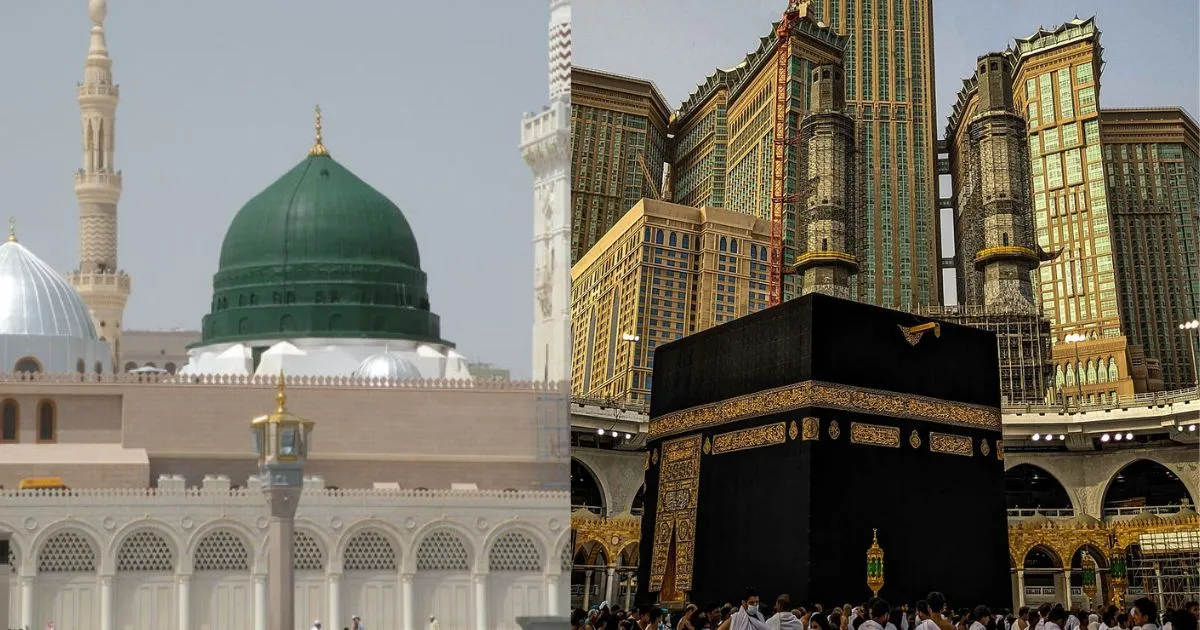What is the relationship between Medina and Mecca in Islamic history and culture?
Table of Contents
What is the relationship between Medina and Mecca in Islamic history and culture?
Malcolm X once said, “The pilgrimage to Mecca is one of the most significant experiences in the life of a Muslim.” This quote shows how important Mecca is in Islamic culture. You might wonder about Medina’s location and its role in Islamic history. Mecca is where Islam began, and Medina is where the Prophet Muhammad started the first Islamic state.
The bond between Mecca and Medina is intriguing. Learning about their connection can give you a deeper understanding of Islamic history and culture. If you’re curious about Medina’s location and its importance, you’re in the right place. Exploring their relationship will show you how these cities are connected and their impact on Islamic culture.
Introduction to Medina and Mecca
As you explore Mecca and Medina’s history, you’ll see how these cities are key to Islamic culture. The Prophet Muhammad’s journey from Mecca to Medina and the founding of the first Islamic state are significant events. Medina’s location is of great interest, and knowing its significance can deepen your appreciation for Islamic culture.
Key Takeaways
- Mecca is considered the birthplace of Islam
- Medina is the city where the Prophet Muhammad established the first Islamic state
- The location of Medina is significant in Islamic history and culture
- Understanding the relationship between Mecca and Medina can provide valuable insights into Islamic culture
- The connection between Mecca and Medina is rooted in their history and cultural context
- Where is the city of Medina, and what is its significance, are common questions that can be answered by exploring the relationship between these two cities
Understanding the Sacred Cities of Medina and Mecca
As you explore Islamic history and culture, you’ll learn about two key cities: Mecca and Medina. Mecca is famous as Islam’s birthplace and home to the Kaaba, Islam’s holiest site. Medina, on the other hand, is where the Prophet Muhammad rests. Knowing their importance and roles in Islamic worship is crucial.
In Medina, you’ll find the Masjid an-Nabawi, a huge mosque that’s a key pilgrimage site. The city’s history and culture are deeply rooted in Islamic heritage. Some key points about Medina include:
- The Prophet Muhammad’s move to Medina started the Islamic calendar
- The city is a hub for Islamic learning and culture
- Medina played a big role in shaping Islamic history and tradition
By diving into the history, culture, and spiritual importance of Mecca and Medina, you’ll understand their deep connection. This connection is vital in Islamic tradition.
The Historical Connection Between Medina and Mecca
Exploring Islam’s history reveals a deep bond between Medina and Mecca. The location of Medina was key in the Prophet Muhammad’s life. It was where he set up the first Islamic state. The journey from Mecca to Medina, known as the Hijra, started a new chapter in Islamic history.
Medina’s establishment as the first Islamic state was a major milestone. It set the stage for Islam’s spread across the Arabian Peninsula. The location of Medina was strategic, fostering a strong, unified Islamic community. It became a hub for Islamic learning and culture, drawing scholars and Muslims from everywhere.
Some key events in Medina and Mecca’s history include:
- The Hijra: The Prophet Muhammad’s journey from Mecca to Medina, marking the beginning of the Islamic calendar.
- The establishment of the first Islamic state: Medina became the center of the Islamic community, with the Prophet Muhammad as its leader.
- The return to Mecca: The Prophet Muhammad’s return to Mecca, where he unified the Arabian Peninsula under Islamic rule.
The bond between Medina and Mecca shows their importance in Islamic history and culture. The location of Medina remains a vital part of Islamic heritage. Millions of Muslims visit each year to honor the Prophet Muhammad and the early Islamic community.
The Spiritual Significance of Islam’s Two Holy Cities
As you explore the world of Islam, you might ask where Medina is and why it matters. Medina, along with Mecca, is a key holy city in Islam. These cities are important for Islamic worship because of their history and link to the Prophet Muhammad.
Medina is crucial in Islamic history. It’s where the Prophet Muhammad started the first Islamic state. It’s also where the Prophet is buried. Mecca, meanwhile, is where Islam began, as it’s where the Prophet Muhammad first received a revelation.
Key Aspects of Medina and Mecca
- Mecca: The birthplace of Islam and the city where the Prophet Muhammad received his first revelation.
- Medina: The city where the Prophet Muhammad established the first Islamic state and is now the final resting place of the Prophet.
- Both cities play a significant role in Islamic worship and are considered the two holiest cities in Islam.
Understanding Mecca and Medina’s spiritual importance shows their deep connection to Islam. Whether you’re curious about Medina’s location or want to know their role in Islamic worship, their historical and cultural value is key.
| City | Significance |
|---|---|
| Mecca | Birthplace of Islam, first revelation of the Prophet Muhammad |
| Medina | Establishment of the first Islamic state, final resting place of the Prophet Muhammad |
Geographical and Cultural Landscape of the Holy Cities
Exploring Medina and Mecca shows us they’re in the Arabian Peninsula. This area is famous for its huge deserts and rich culture. The mix of old and new buildings in these cities shows their deep importance in Islamic history and culture.
Medina’s location near the Arabian Desert has greatly influenced its culture. Buildings and monuments here are made to stand up to the desert’s harsh weather. Mecca, in the Hijaz region, is a key spot for trade and commerce. It draws visitors and pilgrims from everywhere.
Some key features of these holy cities include:
- Unique architectural styles, blending traditional and modern elements
- A rich cultural heritage, shaped by the cities’ history and significance in Islamic culture
- A diverse range of natural landscapes, from deserts to mountains and valleys
Understanding Mecca and Medina’s geography and culture helps us appreciate their importance in Islamic history. Medina’s unique architecture, blending old and new, shows how its location has shaped its culture.
Conclusion: The Eternal Bond Between Islam’s Most Sacred Places
Reflecting on Mecca and Medina, you see a deep bond in Islamic history and culture. The Prophet Muhammad’s move from Mecca to Medina was key. It started the first Islamic state and shaped the faith’s spiritual side.
Mecca, where Islam began, and Medina, the Prophet’s city, are deeply revered by Muslims. These places are more than locations; they symbolize strong faith and legacy. The tie between Mecca and Medina shows the power of belief and devotion that has kept Islam alive for centuries.
Exploring the link between Mecca and Medina gives a deep look into Islamic tradition. May your journey find inspiration in the lasting connection between these sacred sites.
FAQ
Where is the city of Medina located?
Medina is in western Saudi Arabia, about 280 miles (450 km) north of Mecca. It’s in a valley, surrounded by mountains. It’s one of Islam’s holiest cities.
What is the significance of Medina in Islamic history and culture?
Medina is very important in Islamic history and culture. It’s where the Prophet Muhammad started the first Islamic state. It’s also where he is buried.
Medina is the second most sacred place in Islam, after Mecca. It’s a key stop for Muslim pilgrims.
How is Medina connected to Mecca in Islamic history?
Medina and Mecca are closely linked in Islamic history. The Prophet Muhammad’s move from Mecca to Medina, known as the Hijra, started a new era. In Medina, he created the first Islamic state.
This state helped spread Islam across the Arabian Peninsula. Going back to Mecca and uniting the peninsula under Islam was a major achievement.
What is the spiritual significance of Medina in Islam?
Medina is known as the “City of the Prophet.” It’s where the Prophet Muhammad lived, preached, and was buried. It’s home to the Masjid al-Nabawi, which has the Prophet’s mosque and tomb.
This makes Medina a sacred place for Muslim pilgrims.
How does the geography and culture of Medina contribute to its significance in Islam?
Medina’s location and culture add to its importance in Islam. It’s in a valley, surrounded by mountains, which has influenced its layout and architecture. The city’s culture is deeply rooted in Islamic traditions.
It combines traditional and modern elements, showing its rich history and role as a center of Islamic learning and spirituality.

